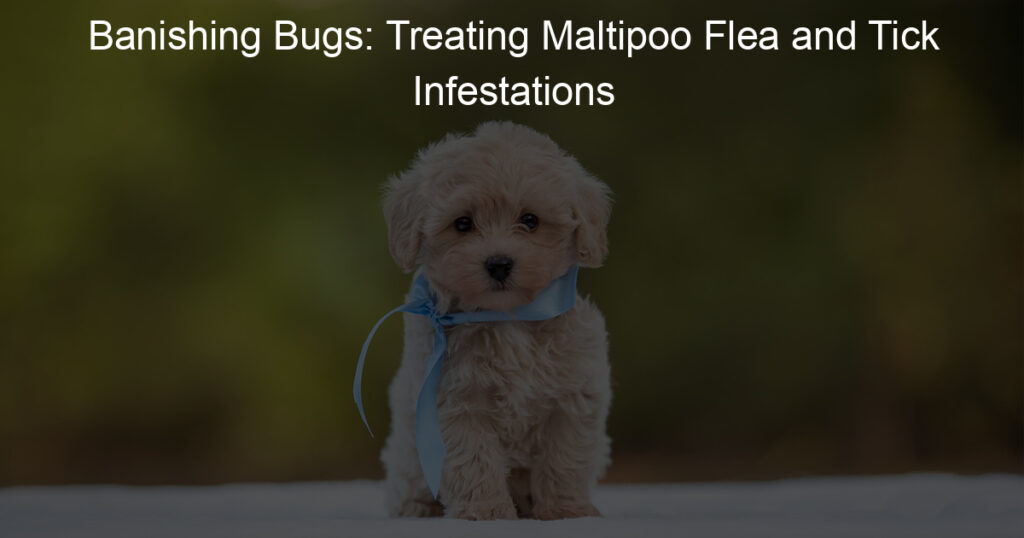
Introduction to Maltipoo Flea and Tick Infestations
If you’re a Maltipoo owner, you know that these adorable dogs are a joy to have around. But like all pets, they can sometimes face health issues. One such problem is flea and tick infestations. This article will help you understand the problem and highlight the importance of treating it promptly.
- Understanding the problem
- Importance of treating Maltipoo flea and tick infestations
Fleas and ticks are tiny parasites that can cause a lot of discomfort for your Maltipoo. They latch onto the skin and feed on the dog’s blood. This can lead to itching, redness, and even infections. Fleas can also cause allergic reactions in some dogs, leading to severe itching and skin problems. Ticks, on the other hand, can transmit diseases like Lyme disease and Rocky Mountain spotted fever.
It’s crucial to treat flea and tick infestations as soon as possible. Not only do these parasites cause discomfort and distress for your pet, but they can also lead to serious health issues if left untreated. Fleas can cause anemia in severe cases, and ticks can transmit dangerous diseases. Furthermore, these parasites can also infest your home, causing a risk to other pets and even humans. Therefore, prompt and effective treatment is essential.
In the following sections, we will delve deeper into the causes of Maltipoo infestations, how to identify flea and tick problems, various treatment options, and preventive measures. We will also share some case studies to provide a comprehensive understanding of this issue. Stay tuned to learn how to keep your Maltipoo healthy and happy.
Causes of Maltipoo Infestations
As a Maltipoo owner, it’s crucial to understand the causes of flea and tick infestations. This knowledge can help you prevent these pesky parasites from making your beloved pet their home. Let’s delve into the causes of Maltipoo flea infestations.
Maltipoo Flea Infestation Causes
There are various reasons why your Maltipoo might be suffering from a flea infestation. The two most common causes are environmental factors and interaction with infested animals.
- Environmental Factors
- Interaction with Infested Animals
Fleas thrive in warm, humid environments. If your Maltipoo spends a lot of time outdoors, especially in grassy or wooded areas, they are at a higher risk of picking up fleas. Fleas can also infest your home through cracks and crevices, or hitch a ride on your clothing or other pets.
Fleas are excellent jumpers. If your Maltipoo is around other animals that are infested with fleas, there’s a high chance they might get infested too. This is especially true in places like dog parks, where your pet interacts with many other animals.
Understanding these causes is the first step towards protecting your Maltipoo from fleas. In the next section, we’ll discuss the causes of Maltipoo tick infestations.
Maltipoo Tick Infestation Causes
Understanding the causes of tick infestations in Maltipoos is crucial to prevent these bothersome parasites from affecting your beloved pet. Let’s explore the two main causes:
- Exposure to Tick-Infested Areas
- Interaction with Tick-Infested Animals
One of the primary reasons for tick infestations in Maltipoos is their exposure to areas heavily infested with ticks. These areas could include tall grasses, woods, or even your backyard if it’s not properly maintained. Ticks are crafty creatures that latch onto your pet when it passes by, making it easy for them to infest your Maltipoo.
Another common cause is the interaction of your Maltipoo with other animals that are already infested with ticks. This could be during a walk in the park, a playdate with a friend’s pet, or even interaction with a wild animal. Ticks can easily transfer from one host to another, making it important to be cautious of the animals your Maltipoo interacts with.
Being aware of these causes can help you take the necessary precautions to protect your Maltipoo from tick infestations. Remember, prevention is always better than cure.
Identifying Maltipoo Flea and Tick Problems
It’s crucial for every Maltipoo owner to know how to identify flea and tick problems. These tiny pests can cause significant discomfort and health issues for your pet. Here, we’ll discuss the signs of flea and tick infestations in Maltipoos.
-
Signs of Flea Infestation
Fleas are small, brown insects that feed on your Maltipoo’s blood. They can cause itching, redness, and discomfort. Here are some signs that your Maltipoo might have a flea infestation:
- Excessive scratching: If your Maltipoo is scratching more than usual, it could be due to fleas.
- Red patches on the skin: Fleas can cause red, inflamed patches on your pet’s skin.
- Flea dirt: This looks like small, black specks in your pet’s fur. It’s actually flea feces, which is a clear sign of infestation.
-
Signs of Tick Infestation
Ticks are larger than fleas and attach themselves to your Maltipoo’s skin to feed on their blood. They can transmit diseases, so it’s important to remove them promptly. Here are some signs of a tick infestation:
- Visible ticks: Ticks can often be seen with the naked eye. They look like small, dark spots on your pet’s skin.
- Unusual lumps: If you feel a small lump on your pet’s skin, it could be a tick.
- Changes in behavior: If your Maltipoo seems lethargic or unwell, it could be due to a tick-borne disease.
Remember, the best way to protect your Maltipoo from fleas and ticks is through prevention. Regularly check your pet’s fur and skin for signs of these pests, and consult with your vet about the best preventative treatments.
Treating Maltipoo Fleas and Ticks
When it comes to treating fleas and ticks on your Maltipoo, there are several effective methods available. These methods can be divided into three main categories: topical treatments, oral medications, and natural remedies. Let’s delve into each of these categories to understand how they work.
Flea Remedies for Maltipoo
- Topical Treatments
- Oral Medications
- Natural Remedies
Topical treatments are applied directly to your Maltipoo’s skin. They work by killing fleas and ticks on contact, preventing them from biting your pet. Some topical treatments also have the added benefit of repelling fleas and ticks, providing an extra layer of protection for your Maltipoo.
Oral medications are another effective way to treat fleas and ticks. These medications are given to your Maltipoo by mouth and work by killing fleas and ticks from the inside out. Oral medications are often recommended for severe infestations, as they can quickly reduce the number of fleas and ticks on your pet.
Natural remedies can also be used to treat fleas and ticks on your Maltipoo. These remedies often involve the use of natural ingredients, such as essential oils, to repel and kill fleas and ticks. While natural remedies can be effective, they may not be as potent as topical treatments or oral medications. Therefore, they are often used in conjunction with other treatments for the best results.
In conclusion, treating fleas and ticks on your Maltipoo involves a combination of topical treatments, oral medications, and natural remedies. It’s important to consult with your vet to determine the best treatment plan for your pet.
Tick Treatment for Maltipoo
When it comes to treating ticks on your Maltipoo, there are several effective methods you can use. These methods can be broadly divided into two categories: tick removal techniques and medications and treatments. Let’s take a closer look at each of these categories.
- Tick Removal Techniques
- Wear gloves to protect your hands.
- Use a pair of fine-tipped tweezers to grasp the tick as close to your pet’s skin as possible.
- Pull upward with steady, even pressure. Don’t twist or jerk the tick as this can cause the mouth-parts to break off and remain in the skin.
- After removing the tick, thoroughly clean the bite area and your hands with rubbing alcohol or soap and water.
- Medications and Treatments
- Topical treatments: These are applied directly to your pet’s skin, usually at the back of the neck where they can’t lick it off. They work by killing ticks on contact or when they bite your pet.
- Oral medications: These are given by mouth and work by killing ticks once they bite your pet. They are usually effective for a month.
- Tick collars: These are worn around your pet’s neck and release a pesticide that kills ticks. They need to be replaced every few months.
Removing ticks from your Maltipoo can be a delicate process. It’s important to ensure that the entire tick, including its head, is removed to prevent further infection. Here are some steps to follow:
There are several medications available that can help treat and prevent tick infestations in Maltipoos. These include:
It’s important to consult with your vet before starting any new medication or treatment for your Maltipoo. They can help you choose the best option for your pet based on their age, size, and overall health.
Maltipoo Infestation Treatments: Case Studies
Let’s take a closer look at two case studies that demonstrate successful treatments for Maltipoo flea and tick infestations. These examples will provide practical insights into how these infestations can be effectively managed.
-
Case study 1: Successful Use of Topical Treatments
In this case, a 2-year-old Maltipoo named Bella was suffering from a severe flea infestation. Her owner tried various over-the-counter treatments with little success. Finally, they consulted a veterinarian who recommended a specific topical treatment.
The topical treatment was applied directly to Bella’s skin, between her shoulder blades, once a month. The treatment worked by killing fleas on contact, before they could lay eggs. After two months of consistent use, Bella’s flea infestation was completely eradicated.
This case study demonstrates the effectiveness of topical treatments when used correctly and consistently. It also highlights the importance of consulting a professional when over-the-counter treatments are not effective.
-
Case study 2: Effective Natural Remedies
In another case, a Maltipoo named Max was dealing with a tick infestation. Max’s owner was hesitant to use chemical treatments and sought out natural remedies instead.
They began by thoroughly cleaning Max’s living area and regularly checking Max for ticks. They also used a natural tick spray made from essential oils like eucalyptus and lemongrass. After a few weeks of diligent care and natural treatment, Max’s tick problem was significantly reduced.
This case study shows that natural remedies can be an effective alternative to chemical treatments. However, they often require more time and effort from the pet owner.
These case studies illustrate that there are multiple ways to effectively treat Maltipoo flea and tick infestations. The best approach depends on the severity of the infestation, the pet’s health, and the owner’s preferences.
Preventing Maltipoo Flea and Tick Infestations
Preventing flea and tick infestations in your Maltipoo is crucial to ensure their health and happiness. By taking a few simple steps, you can protect your furry friend from these pesky parasites.
Tick and Flea Prevention for Maltipoo
There are several effective methods to prevent ticks and fleas from infesting your Maltipoo. Here are the top three:
- Regular grooming and checks
- Use of preventive medications
- Environmental control
Regular grooming is not only good for your Maltipoo’s coat and skin, but it’s also an excellent way to check for fleas and ticks. Brush your Maltipoo daily and inspect their skin and fur closely for any signs of these parasites. Regular baths with a flea and tick shampoo can also help prevent infestations.
There are many over-the-counter and prescription medications available that can prevent fleas and ticks. These medications come in various forms, including topical treatments, oral tablets, and collars. Consult with your vet to determine the best option for your Maltipoo.
Keeping your home and yard clean and free of debris can help prevent flea and tick infestations. Regularly vacuum your home, especially areas where your Maltipoo spends a lot of time. In your yard, keep grass and bushes trimmed and remove any leaf litter or other debris where fleas and ticks might hide.
In conclusion, preventing flea and tick infestations in your Maltipoo requires a combination of regular grooming, use of preventive medications, and environmental control. By following these steps, you can help ensure your Maltipoo stays healthy and free of these troublesome parasites.
Conclusion: Managing Maltipoo Flea and Tick Issues
In conclusion, dealing with flea and tick infestations in Maltipoos can be a challenging task. However, with the right knowledge and strategies, you can effectively manage these issues and keep your furry friend healthy and happy. Let’s summarize the key points we’ve discussed.
- Importance of Regular Prevention
- Seeking Professional Help When Needed
Prevention is always better than cure. Regularly checking your Maltipoo for fleas and ticks, using preventative treatments, and maintaining a clean environment can significantly reduce the risk of infestations. Remember, fleas and ticks can cause serious health problems for your pet, including skin irritations, infections, and diseases like Lyme disease. Therefore, it’s crucial to take preventative measures seriously.
If your Maltipoo is suffering from a severe flea or tick infestation, it’s important to seek professional help. Veterinarians have the expertise and resources to effectively treat these issues and can provide tailored advice for preventing future infestations. Don’t hesitate to consult a vet if you’re struggling to manage your pet’s flea and tick problems.
In the end, managing Maltipoo flea and tick issues is all about being proactive and vigilant. By taking the right steps, you can ensure your Maltipoo leads a comfortable, itch-free life. Remember, your pet’s health and well-being are in your hands. So, stay informed, stay prepared, and take action when needed.








